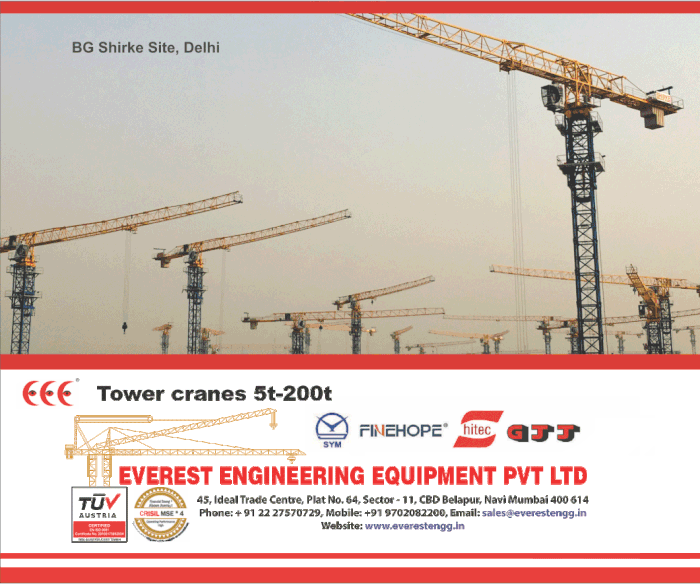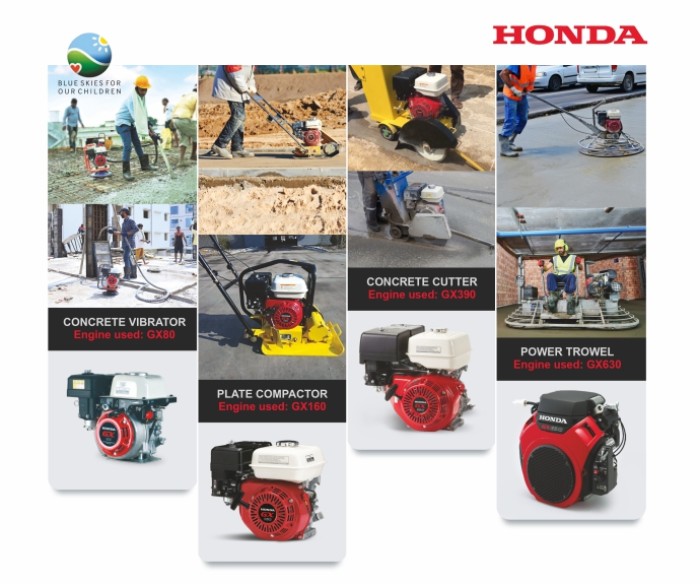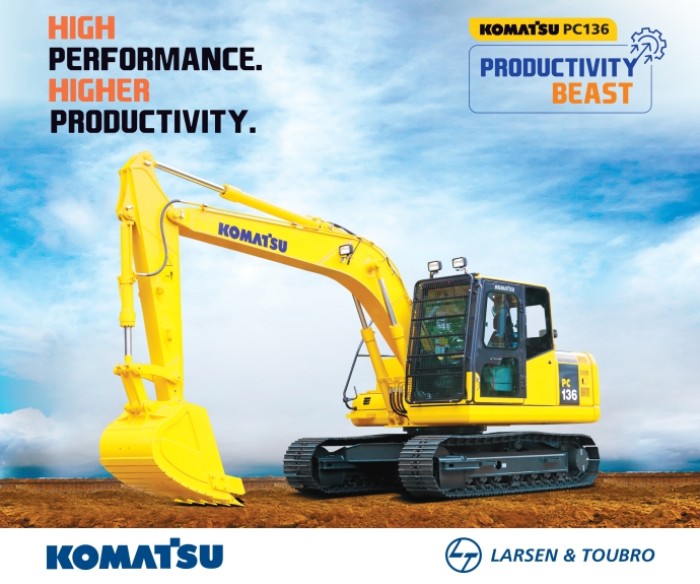India’s construction equipment industry to reach $25 bn by 2030
Construction Equipment: Innovations that are shaping the future of CE Industry!
India’s construction equipment industry is expected to grow at a CAGR of 12 per cent to reach $25 billion by the end of this decade, aided by the government’s focus on expanding the infrastructure sector, a report by Indian Construction Equipment Manufacturers Association (ICEMA) reveals.
The construction industry is undoubtedly one of the most important and booming sectors in the global economy.
From cloud-based collaboration to robots and artificial intelligence an incredible array of developments are improving the way buildings and infrastructure development happens in India.
India is the world’s third largest market for construction equipment (CE) with an industry size of around $10 billion (FY24) and has the potential to transform into a manufacturing and export hub, the industry body notes.
“As a result of current announced infrastructure investments in India, the CE industry is expected to reach $25 billion in FY30, posting a CAGR of 12 percent with an envisaged investment in the industry value chain of around $4 billion, which includes around $1 billion over next five years in manufacturing by OEMs and 3X investment (around $3 billion) by suppliers, component manufacturers and distribution channels,” ICEMA said in the report, 2035 Construction Equipment Market Outlook for India.
Indian CE market has more than 50 OEM manufacturers and provides employment to more than 3 million people (direct and indirect). Indian construction equipment trade with the world is around $3 billion, of which imports are $2.6 billion and exports are around $500 million.
“By FY35, the CE industry is expected to reach $37 billion. However, with the commencement of the government’s ambitious Amrit Kaal vision to make India an economic and manufacturing hub by using long-term infrastructure investments, the CE industry could grow at a faster rate to achieve a market size of $42 billion in FY35,” the report noted.
With the expanding infrastructure investments in India combined with ambitious goals of making India a manufacturing hub, the CE industry in India is set to focus on enhancing exports.
India’s CE exports are currently worth about $0.7 billion comprising 0.4 per cent of global CE market size, which is projected to grow to $3 billion by 2030 (1.2 per cent of global market), it added.
Earthmoving equipment is the dominant segment with a 72 per cent share in FY23 and is expected to continue to dominate the market with an 81 per cent share in FY35. This is followed by concrete and material handling, with almost 11 per cent share in FY23 and a 6 per cent share in FY35.
The smallest segments are road construction and material processing, with 4 per cent and 2 per cent in FY23 and 6 per cent and 1 per cent in FY35, respectively, the report said.
The construction industry is experiencing a dynamic era of rapid innovation. In many ways, construction equipment manufacturers are starting to mirror Silicon Valley tech firms — advancing in telematics, autonomous machinery and electromobility — to name a few. More than ever, strategic partnerships among equipment makers and equipment users are driving this change.
This is great news for an industry that in the past may have lagged behind transportation, agriculture and other industries. As new, creative technologies come on board, manufacturers are improving products and services to ensure better machine uptime, higher machine lifecycle values and unique customer solutions.
The most important developments in construction equipment technology are in the following fields. Given below are the top major construction technology trends to watch out for:
1. Remote - Control Mining
Like drones, operators are controlling equipment from digital cockpits to advance mining projects. Developments in 5G technology bring remote operation of heavy equipment miles down in a mine from a safe above-ground location. This takes humans out of dangerous conditions and helps attract new workers because it’s less dangerous, dirty and plays more like a video game. See how Volvo will be testing remote-controlled wheel loaders in the near future.
How Remote Control Technologies Improve Mining Performance
High performing radio remote control tools have the ability to fine-tune all mining and excavation operations to include improvements in network connectivity, operational flexibility and locationindependent operations, and decreased labor costs. This greatly increases safety conditions and saves in labor costs. Refinements in these areas give mining operations the conditions that promote expansion and keep up with modern industry demands.
Adaptable Equipment Operation
Without the need for mining equipment to be controlled from within the cab, projects require less operators to complete complex tasks remotely. Remote controls give an operator functionality of one or more machines from distances up to 1,250 miles away from the excavation site. Heavy mining equipment such as drills, shovels and haulers can be controlled by one operator from a singular location. This form of operation offers the advantage of a beneficial vantage point and saves in time and costs of manpower.
Improved Network Connectivity
The success of a mining and excavation operation is fully dependent on its network connectivity. Automation makes it possible for a network of dispatchers and operators to share information and deploy production fleets in real time using remote control systems.
Remote Controls Enhance Operations
To build a mining ecosystem that performs efficiently and with cutting edge innovations, it’s necessary to incorporate radio remote control systems into your operations. The benefits include:
• The improvement of safety conditions
• Lowered labor and operation costs
• Mining performance that is adaptable for projects of all sizes
• Improved mining network connectivity.
2. Connected Machines
Telematics and the Internet of Things are changing job sites that build skyscrapers, power plants, mines and more. The machines are communicating with one another and home base. It’s more efficient and dramatically increases safety.
Introduction to IoT in Construction Equipment Understanding the Basics of IoT
Before diving into the specifics, let’s take a moment to understand the fundamentals of IoT. At its core, the Internet of Things refers to the network of physical devices, vehicles, appliances, and other objects embedded with sensors, software, and connectivity that enable them to collect and exchange data. This interconnected network allows for seamless communication and collaboration between devices, creating a web of smart technology.
IoT has revolutionized various industries, and the construction sector is no exception. By integrating IoT technology into construction equipment, regular machines can be transformed into smart, interconnected devices that can communicate and collaborate seamlessly. This opens up a world of possibilities for the construction industry, enabling it to leverage real-time data and optimize operations.
The Role of IoT in the Construction Industry
With its ability to provide real-time data, IoT holds immense potential for the construction industry. Connected machines have the power to transform the way construction companies operate, optimize operations, and streamline processes. By harnessing the data collected by IoT-enabled devices, construction companies can make informed decisions, improve project management, and enhance safety measures. One of the key benefits of IoT in construction equipment is its ability to improve project management. With real-time data on equipment performance, location, and usage, project managers can monitor progress, identify bottlenecks, and make timely adjustments to ensure projects stay on track. This level of visibility and control can significantly improve project efficiency and reduce delays and cost overruns.
Furthermore, IoT can enhance safety on construction sites. By equipping equipment with sensors, construction companies can monitor environmental conditions, detect potential hazards, and alert workers in real-time. For example, sensors can detect high levels of toxic gases or unstable structures, enabling workers to take immediate action and prevent accidents.
In addition to project management and safety, IoT can also optimize equipment maintenance. By collecting data on machine performance, usage patterns, and maintenance needs, construction companies can implement predictive maintenance strategies. This means that instead of waiting for equipment to break down, companies can proactively address maintenance issues, reducing downtime and extending the lifespan of their equipment.
Overall, IoT technology is revolutionizing the construction industry by enabling the transformation of traditional construction equipment into smart, interconnected devices. With real-time data, improved project management, enhanced safety measures, and optimized equipment maintenance, construction companies can achieve greater efficiency, productivity, and profitability.
3. Autonomous Machines
Self-driving machines are a reality. Autonomous vehicles will be successful in construction long before they take over commuter roads. They’ll be used on closed sites, with limited circulation of pedestrians and other machines, before coming to the city. Learn more about our HX2 autonomous, battery-electric load carrier.
Autonomous dozers, excavators, load-carriers and haul trucks can be used for excavating and grading soil on construction sites. Small rovers can follow workers around carrying tools and materials. The vehicles are often connected to allow for coordinated actions.
Autonomous construction vehicles such as dozers, excavators, load-carriers and haul trucks can be used for excavating and grading soil on the construction site. One operator can supervise several autonomous machines working simultaneously.
Another, smaller kind of autonomous or semiautonomous construction vehicles are called rovers. They are able to follow workers around on the construction site carrying tools and materials.
The autonomous vehicles operate by means of LiDAR sensors detecting obstacles in the surroundings, inertial measurement units (IMUs), and global positioning system (GPS) technology. This allows the vehicles to know their exact position on site, and typically a geofence prohibits the vehicles from operating off-site. The vehicles are often connected to other autonomous and non-autonomous vehicles on-site, allowing for coordinated actions.
Benefits and challenges
• Improved safety as the operator is detached from the machine and hereby is less exposed to shock, dust, heavy lifting and vibrations.
• Improved labor productivity, as one operator can manage several machines
• Whereas autonomous cars are restricted by regulatory challenges before they can move to public areas, autonomous construction vehicles can be tested within enclosed industrial settings
• Tight construction schedules enabled, as the machines can operate efficiently 24 hours a day.
• Precision work like working around buried utilizes and operation in high traffic conditions is challenging
4. Predictive Analytics/Telematics
The most imminent changes are coming with uptime. Connected machines are sending tons of information that can be used for actionable predictions. For example, knowing a machine will break down enables companies to take them offline for maintenance before a jobsite is unexpectedly thrown to a halt. The big change is that some OEMs are receiving all of this data and filtering it for dealers and customers, sending them only actionable alerts. Manufacturers also send along advanced reporting, created by a team of experts. Learn more on how our ActiveCare Direct program works.
Construction jobsites can be busy and confusing.With multiple pieces of equipment, assets, and personnel performing a wide variety of duties, it can be seemingly impossible to get all the moving components to form a cohesive workforce.
Construction telematics allows equipment managers to:
• Monitor and report on all assets in one platform
• Automate maintenance management
• Locate lost, stolen or missing assets
• Access crucial information on your mobile device
Construction Equipment Utilization
Keeping a construction site up and running can quickly turn into a series of challenges. However, we can avoid many of those challenges with proper equipment management solutions. Being able to quickly see the day-to-day efficiency of both assets and equipment can provide a window into how to stay under budget, keep progress flowing according to schedule, and increase efficiency.
Proper construction equipment utilization can:
• Reduce equipment hoarding
• Prevent unnecessary hire costs
• Increase jobsite productivity
The ability to see the total number of assets on a jobsite, the active days of a project, engine hours and equipment utilization represented as a percentage all on one screen provides valuable insights that can be tracked over time to determine productivity. Equipment and crewmember optimization can cut down on unneeded assets, slash idle time and fuel use, and avoid unexpected maintenance issues.
Data-driven solutions
Using data-driven solutions, the productivity of a jobsite can be monitored and compared over time, or with the findings of another site.
Being able to track such valuable areas like time spent on site that can be cross-referenced with usage, accumulate fuel costs for one piece of equipment or the whole site, or calculating contractor costs can provide valuable insights into how a job is progressing.
Knowing where all assets are located on one screen can also keep your bottom line in check as well. It can help cut back on unnecessary rentals and keep headcount exactly where it needs to be. By monitoring utilization across the board, jobsite productivity can be increased and downtime of both crewmembers and assets can be virtually eliminated.
5. Electromobility
Easy for a Prius, but not for large machines that must lift and haul tons of materials. Hybrid and new battery technologies are being tested around the world. They are quieter, more efficient and more sustainable. For example, garbage trucks that switch to electric can work during the night because there is no noise. Learn more about our plans to launch Volvo electric excavators and electric wheel loaders.
After passenger and commercial vehicles, another segment is getting ready for an electric charge — construction and industrial equipment. Top names in the business like JCB, Volvo CE and Schwing Stetter are either already working on electric versions of some of their big yellow machines or conducting feasibility studies for the launch of select global e-applications in India.
Construction machines emit approximately 400 metric tons of CO2 emissions annually, which is equal to 1.1% of all CO2 emissions worldwide. The decarbonization of the construction industry is now considered a global priority, as countries attempt to meet their Paris Agreement commitments. Some cities are considering the introduction of low emission zones where they will ban or charge for the operation of heavily polluting vehicles, which will add substantial cost to construction projects that are using diesel equipment.
Electric construction vehicles are one solution. While on-road electric vehicles are becoming commonplace, the off-road electric construction vehicle market is still in its infancy. Companies like Caterpillar, Hyundai, Komatsu, JCB and Volvo are creating prototypes and readying the market for this inevitable shift. Case in point, the Volvo Construction Equipment fleet is set for netzero emissions by 2050. Soon, everything from backhoe and skid steer loaders to concrete mixers will be electrified.
The electrification of construction vehicles is being led by the development of small compact machines including mini-excavators, small wheel loaders and dump trucks. This is largely because such machines are used in urban environments, and many cities want to lower both exhaust emissions and noise. Since their daily duty cycle is lighter than that of larger machines, power demand can be met with a workable-sized li-ion battery and electric motor.
Cost, range and power availability are the key concerns as electromobility becomes mainstream. With increase in demand, EV prices are predicted to become competitive with their internal combustion engine (ICE) counterparts in the lightduty sector by 2025. Increased battery capacity in new iterations allow vehicles to travel longer on one charge. Battery degradation and range restrictions are still among the product’s primary limitations. The newest models are built to account for the degradation that happens over the course of full charge cycles and to meet or exceed ICE output while providing instant torque.
6. Virtual Dealership
Dealers are taking cues from other industries, such as Amazon and Walmart, by having a stronger online presence in the future. Dealers will become “uptime managers,” as they use augmented reality for consultation and repairs, and parts and services are going online with digital records, for example. Software updates on machines will be pushed/received automatically from the cloud.
It’s clear that these new technologies will rapidly change the construction industry. New investments bring along great opportunities for OEMs to help customers drive efficiency on the jobsite, improve their labor force, make decisions based on pure data and ultimately grow their business.
We are not far away from a real transformation in the industry. Recent results of an electric site research project performed in a few countries showed a 98 percent reduction in carbon emissions, a 70 percent reduction in energy cost and a 40 percent reduction in operator cost. Soon, we’ll see zero emissions, zero unplanned downtime and zero accidents be the industry standard.
















Leave a comment